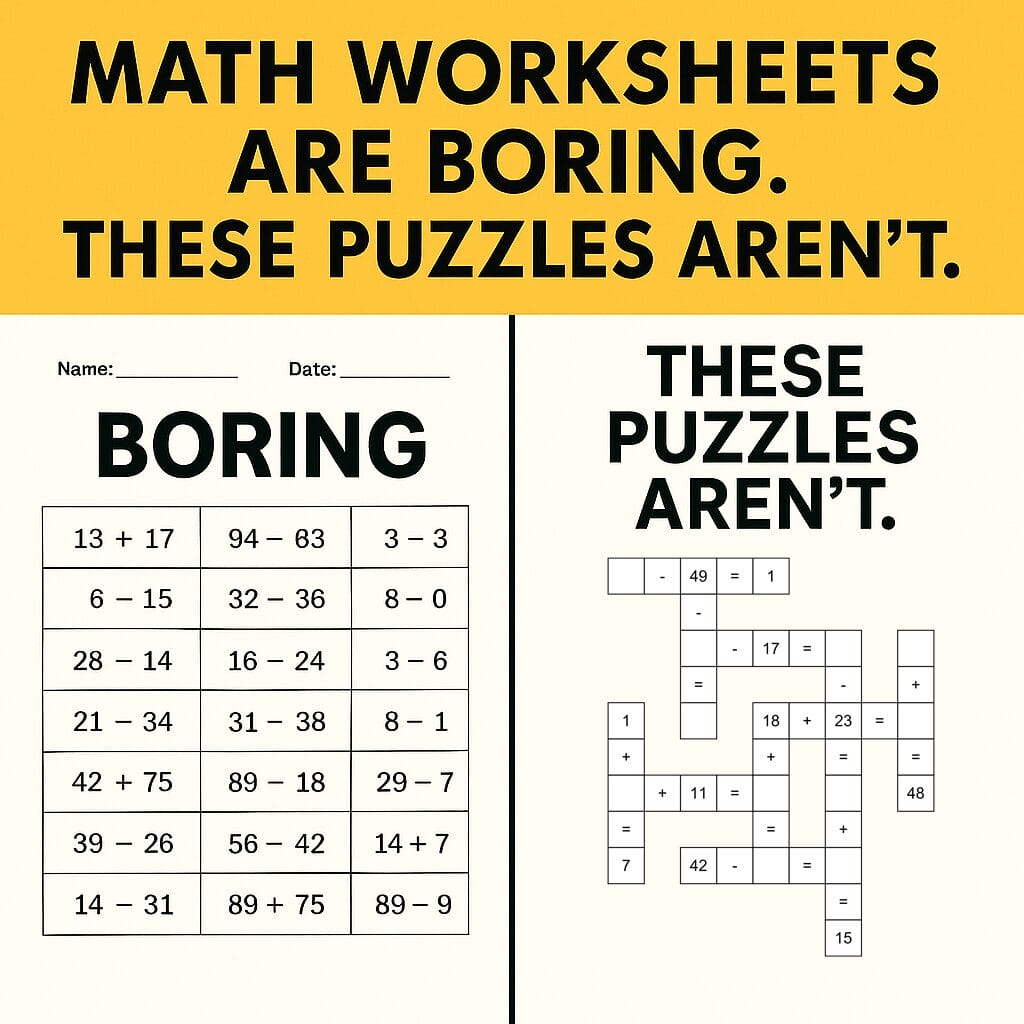Math Worksheets Are Boring. These Puzzles Aren’t.
Let’s be honest: traditional math worksheets can be soul-crushing. For students, they’re a blur of numbers and repetition. For educators and parents, they’re a last-minute print job or a filler activity. And for content creators in the printables space, they often lack the spark that turns casual downloaders into repeat buyers.
But what if your math content could actually spark curiosity? What if solving math problems felt more like solving a game?
That’s the promise of interactive, logic-based math puzzles — especially those in a crisscross format that blend strategy, structure, and satisfaction in every square.

The Real Problem With Worksheets
Worksheets aren’t inherently bad. They offer structure and repetition, which are useful for skill-building. But they often:
- Feel like chores, not challenges
- Lack engagement or visual appeal
- Provide little reward for completion
- Treat math as isolated equations, not a connected system
In a world where attention spans are shrinking, even a second grader can sniff out the difference between “something fun” and “something assigned.”
Let’s look at how puzzle formats — especially math crisscross puzzles — turn this around.
Why Puzzles Work Better (for Brains AND Buyers)

Puzzles tap into the brain’s built-in desire to solve. When done well, they:
- Promote pattern recognition and spatial reasoning
- Make problem-solving feel like a game
- Trigger small dopamine boosts when completed
- Build logical connections between math operations
That applies whether you’re teaching third graders, creating a printables pack for Etsy, or building an engaging math workbook for KDP.
Math crisscross puzzles in particular turn simple equations into connected logic chains. Each number affects the next, which means:
- It’s not about memorization; it’s about solving
- Students have to think, not guess
- Completion feels earned, not endured
Real Classroom & Creator Benefits
Let’s break down how this format helps different roles:
👨🏫 Educators & Homeschoolers
- Differentiate by difficulty level (adjust number range, grid size, operators)
- Great for early finishers or stations
- Fun review activity that doesn’t feel like review
- Adaptable for mental math, special ed, or extension tasks
📅 Etsy / TpT Sellers
- Visually engaging = better conversion on your listings
- More memorable than another worksheet PDF
- Easy to bundle by skill level, grade, or theme
🌟 KDP & PLR Creators
- Use puzzle logic to fill out full interiors
- Batch-produce multiple versions with the same logic
- Add replay value to your books (solutions can be removed or separated)
Whether you’re in a classroom or the creator economy, puzzles offer more than just math practice. They offer connection, challenge, and satisfaction.
Why This Format Specifically?
Math crisscross puzzles aren’t just lists of problems. They’re more like logic webs. Here’s what sets them apart:
- Each equation is positionally linked to another
- You solve through deductive reasoning, not linear memorization
- The visual grid adds spatial and logical reinforcement
Unlike sudoku or word searches, which are language- or pattern-driven, these puzzles are all about math fluency in disguise.
And unlike a basic math sheet, there’s zero filler. Every number connects to a purpose.

OK, But What About the Time It Takes to Make These?
If you’ve ever tried to design a puzzle from scratch, you know it can eat hours:
- Designing the grid
- Ensuring solution accuracy
- Formatting the layout
- Adding branding or style
That’s where digital puzzle tools come in (more on that below).
But the key point is: the format is worth it.
Whether you’re:
- Creating a quick warm-up worksheet
- Publishing a 100-page workbook
- Or developing differentiated resources for your store…
This format instantly elevates your offering.
Bonus: They’re Easy to Level Up
Want to create advanced puzzles?
- Increase number range (up to 1000!)
- Add more equations
- Use dynamic or fixed grid sizes
- Include optional blank puzzles or solution pages
Want to simplify?
- Drop to 1–20 range
- Use fewer equations
- Highlight visual cues with colors or grid markers
The format scales beautifully. You can create a beginner bundle, an intermediate book, and an expert-level challenge set — all from the same structure.
Try It Yourself — And See the Difference
If you’re ready to:
- Make math fun again
- Sell printables people actually enjoy using
- Upgrade your teaching tools without more prep time…
Start by exploring the puzzle format:
Or want to test it out first?
Coming Up Next
This article is the first in a full series:
- Next up: How I Made 4,500 Math Puzzles in 45 Minutes
- Later: Your Printables Are Fine. Now Let’s Make Some That Actually Sell.
Stay tuned — we’re just getting started.
Want to get updates when we publish the rest? Join our email list or follow us on Facebook.
Happy puzzling!
